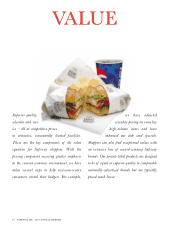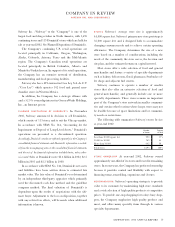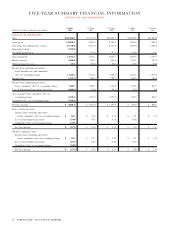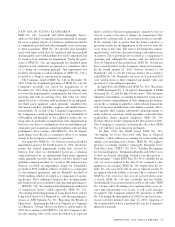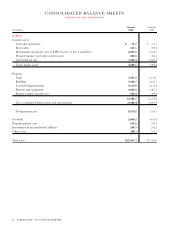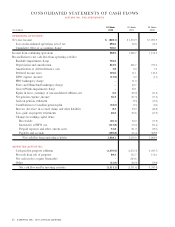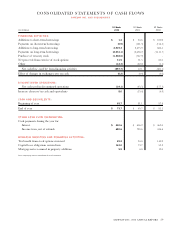Safeway 2002 Annual Report Download - page 21
Download and view the complete annual report
Please find page 21 of the 2002 Safeway annual report below. You can navigate through the pages in the report by either clicking on the pages listed below, or by using the keyword search tool below to find specific information within the annual report.
SAFEWAY INC. 2002 ANNUAL REPORT 19
ment by the Company, performed by taking the original
inventory of assigned leases at the time of the divestitures
and accounting for the passage of time, Safeway expects
that any potential losses beyond those recorded, should there
be any similar defaults, would not be material to Safeway’s
net operating results, cash flow or financial position.
Safeway also recorded a pre-tax charge of $30.1 million
($0.04 per share) in other loss in 2001 to reduce the carrying
amount of the Company’s investment in GroceryWorks
Holdings, Inc. (“GroceryWorks”) to its estimated fair value.
Future Beef Operations Holdings, LLC (“FBO”), a meat
processing company based in Denver, Colorado, was placed
in bankruptcy in March 2002. Safeway was a 15% equity
investor in FBO, had a supply contract for the purchase of
beef from FBO, and had a common board member with
FBO. Safeway had a first-loss deficiency agreement with
FBO’s principal lender which provided that, under certain
circumstances and in the event of a liquidation of FBO being
initiated, Safeway would pay the lender up to $40 million if
proceeds from the sale of collateral did not fully repay the
amount owed by FBO to the lender. Safeway accrued a pre-
tax charge of $51.0 million ($0.06 per share) in other income
(loss) related to the bankruptcy in 2001. The charge was pri-
marily for payments under contractual obligations and the
first-loss deficiency agreement in the event FBO was liqui-
dated. FBO is currently in the process of being liquidated
and Safeway paid the lender $40 million in January 2003.
During the fourth quarter of 2000, Summit Logistics, a
company that operates Safeway’s northern California distri-
bution center, was engaged in a 47-day strike (the “Summit
strike”) which had an adverse effect on sales, product costs
and distribution expenses at 246 Safeway stores in northern
California, Nevada and Hawaii. In 2002, Safeway settled a
dispute with Summit over certain of these distribution
expenses without a material impact to the Company’s
consolidated financial statements. Safeway estimates that the
overall cost of the strike reduced 2000 net income by
approximately $113.8 million ($0.13 per share). Safeway
estimated the impact of the strike by comparing internal
forecasts immediately before the strike with actual results
during the strike.
SALES Identical-store sales (stores operating the entire year
in both 2002 and 2001, excluding replacement stores)
decreased 1.2% in 2002 while comparable-store sales, which
include replacement stores, decreased 0.6%. Sales were
impacted by continued softness in the economy, an increase
in competitive activity, an overly aggressive shrink-reduction
effort and disruptions associated with the centralization of
buying and merchandising.
Identical-store sales
increased 2.0% in 2001,
while comparable-store
sales rose 2.7%. Safe-
way estimates that the
Summit strike in 2000
had a positive impact
on 2001 comparable-
store and identical-store
sales of approximately
50 basis points.
Total sales for 2002
were $32.4 billion, com-
pared to $31.8 billion
for 2001 and $29.4 bil-
lion for 2000. Sales
increased in 2002 pri-
marily due to new store
openings. 2001 sales increases were attributable to the
Genuardi’s Acquisition, new store openings and increased
sales at continuing stores as well as the effect of the Summit
strike in 2000.
GROSS PROFIT Gross profit represents the portion of sales
revenue remaining after deducting the costs of inventory
sold during the period, including purchase and distribution
costs. In addition, advertising and promotional expenses, net
of vendor allowances, are a component of cost of goods sold.
Vendor allowances that relate to the Company’s buying and
merchandising activities consist primarily of promotional
allowances, advertising allowances and, to a lesser extent,
slotting allowances and are included as a component of cost
of sales. Vendor allowances totaled $2.1 billion in 2002 and
2001 and $1.9 billion in 2000. Safeway includes all store
occupancy costs in operating and administrative expense.
Gross profit increased to $10,096.4 million, or 31.16% of
sales, in 2002, from $9,849.6 million, or 30.98% of sales, in
2001 and $8,789.5 million, or 29.85% of sales, in 2000.
The 2002 increase in the gross profit margin was prima-
rily due to shrink control and continued improvements in
buying practices. The increase in the gross profit margin in
2002 was less than in 2001 because much of the Company’s
cost savings were reinvested in pricing and promotion.
Safeway estimates that approximately 26 basis points of
the 2001 increase in the gross profit margin was attributable
to the Summit strike in 2000. The remaining 87-basis-point
improvement was due primarily to continuing improvements
in shrink control, buying practices and private-label growth.
Portions of 2002 Sales Dollar
■ Costs of Goods Sold: 68.8%
■ Operating and Administrative Expense: 23.8%
■ Operating Profits: 5.2%
■ Impairment Charge: 2.2%



